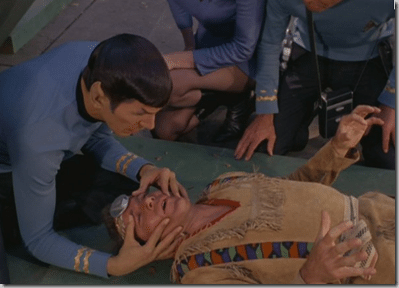Originally posted on May 19, 2014 @ 12:10 PM
Spock Logic in Risk and Safety
 When Star Trek first came on to Australian TV in 1967 I was fascinated by Mr Spock. His weird ears and his cold logic were his trade mark in a show that was so new for those times. Now we look back at the basic graphics and studio mock ups and wonder why we thought it was so good. Spock’s logic stands in contrast to that of the leader Captain Kirk who sometimes overrules Spock because he makes decisions that are ‘arational’ (non-rational) but Spock perceives them to be ‘irrational’. Later in 1983 came Blake’s 7, a British science fiction drama with its own version of Spock, Kerr Avon. Avon, distrusted all emotion and this brought him into constant conflict with the leader, Blake.
When Star Trek first came on to Australian TV in 1967 I was fascinated by Mr Spock. His weird ears and his cold logic were his trade mark in a show that was so new for those times. Now we look back at the basic graphics and studio mock ups and wonder why we thought it was so good. Spock’s logic stands in contrast to that of the leader Captain Kirk who sometimes overrules Spock because he makes decisions that are ‘arational’ (non-rational) but Spock perceives them to be ‘irrational’. Later in 1983 came Blake’s 7, a British science fiction drama with its own version of Spock, Kerr Avon. Avon, distrusted all emotion and this brought him into constant conflict with the leader, Blake.
The funny thing about Spock and Avon Logic is it only works some of the time. Intuition can be equally as important in the management of risk and safety. The key is to get the balance right and to not give primacy to one or the other. However, when it comes to risk and safety there is so little in the risk and safety sector that seeks to understand intuition, the unconscious in learning or human judgment and decision making. When it comes to risk and safety the emphasis is on systems, legislation, regulation and Spock Logic. It seems that being calculative is the foundation for safety logic.
How absurd is it that so many organisations count injury statistics as a indicator of safety culture. That’s like counting smacks as an indicator of effective parenting. Why do we not invest more energy in better understanding the power of the unconscious in decision making? Why do we so devalue to importance of gut knowledge and intuition in risk and safety leadership?
The key to Spock Logic is the power of control. Spock and Avon don’t trust emotion because it can’t be tied down, it seems unpredictable and an immature way of thinking. Yet all the research tells us that this is an illusion. Work by Bargh, Lisbet, Burton and Norretransders show that the majority of our decisions come from the unconscious and subconscious.
The reality is that we don’t turn to a checklist or a Safe Work Method Statement for quick decision making. Neither can these be remembered by a human brain. Many of our decisions are not the sum of individual bits of information but we decide more by the ‘flow’ and feeling of an experience. Take for example a concert pianist who must run their fingers over the keys of the piano in milliseconds. How can they do this and not ‘think’ about each key to be pressed? They practice and practice until the whole piano piece is ‘felt’ and in the end play by ‘flow’. How can a cricket player hit a ball that is coming at them faster than their senses can rationally consider? They may watch the ball leave the bowlers hand but the human brain simply cannot process that information and make a decision in the time the ball gets to the bat. Good batsmen actually play cricket like the piano player, they make decisions according to unconscious ‘flow’. It’s how racing car drivers drive and how we have learned to drive ‘without thinking’.
Scientists know that the human senses maximum flow of conscious sensory perception is about 40 bits a second. Yet, the information and data that our environment throws at the senses exceeds millions of bits per second. Every single second, a human being discards millions of bits of information automatically based on what is important to them. All of this happens unconsciously. So consciousness is not just about information but in some ways is also about discarded information. Consciousness is not really about information anyway. Consciousness is nourished by information but cold Spock logic and rationality is not what it is to be conscious.
However, when we think about the speed of the unconscious it is much faster than the conscious. Our unconscious senses can process information faster than the information that is buzzing about us. Our brain has 86 billion neurons, 400 miles of capillaries, 10 trillion synapses and can make 10,000,000,000,000,000 calculations a second. All of this mental power drives the unconscious but the rational and conscious mind is stuck at 40 bits a second. We have one brain, but it operates at 3 speeds and in 3 modes.
It’s not hard to see that the risk and safety sector do not understand the power of the unconscious and non-rational in decisions making. Just listen how much people explain away various decisions as ‘stupid’ and you will know just how much people don’t understand how decisions are really made by humans. Unless we begin to understand more about how humans truly make decisions we will continue to think that managing risk and safety is a exclusively a rational process. We will continue to prioritise Spock Logic to our own detriment and delude ourselves in the ways we think our organisation is managing risk.



Do you have any thoughts? Please share them below